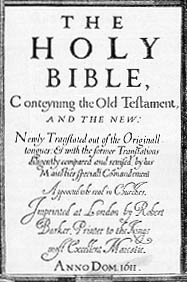Why Was It Called the King James Bible?
In the summer of 1603, King James I was on his way to London to receive the English crown. During this time, he was presented with a petition of grievances by those clergy with Puritan convictions. The King held a conference "for hearing and for determining of things pretended to be amiss in the church." This meeting took place over a three day period, January 14-16, 1604, and is known as the Hampton Court Conference.
Dr. John Reynolds, the leader of the Puritan party and the President of Corpus Christi College at Oxford, made the motion to retranslate the Bible. The majority of the conference attendees were against it. However, the King found it worthy.
Fifty-four of the greatest biblical scholars in Great Britain were chosen to begin the project. They were divided into six groups - three assigned to the Old Testament and three to the New Testament. Two groups from the Old Testament and two from the New Testament were to meet in Oxford, two groups at Cambridge, and two at Westminster.
Of the 54 scholars, only 48 were recorded, as some passed away before the completion of the project, which was not actually begun until about 2-3 years after the committees were assembled. The tranlsation began in 1607, was completed in 1610, and made available to the public in 1611. This version is commonly known as the "1611".
There were fifteen rules that bound the committees. They consulted with translators and commentators of Chaldee, Hebrew, Syrian, Greek, or Latin when in doubt. The new translation was entitled "The Holy Bible", and compared and revised against the previous translations. The Bible was printed by Robert Barker, appointed Printer to the King.
Three editions followed the first printing, which contained a number of misprints. Controversial marginal notes that had been excluded totalled 4,000 notes giving literal meanings of Hebrew words. Also, 765 cross-references in the New Testament, and new chapter and page summaries were implemented. The Old Testament was based upon the same Masoretic text as the previous versions, However, there were no ancient Greek manuscripts for the New Testament until 1628. They didn't have the advantage of using the most accurate resources.
Over the following decades, the spelling of the King James Version has been modernized, misprints have been corrected, the larger chapter summaries have been abridged, and the marginal references have been verified for accuracy. From 1613, a total of 300 differences between the previous translations were rectified. Chronological dates were introduced in 1701. In the 1760s, 30,000 new marginal references were added.
- Source: http://www.christianstudycenter.com
Other reference:
http://www.hti.umich.edu/k/kjv/
